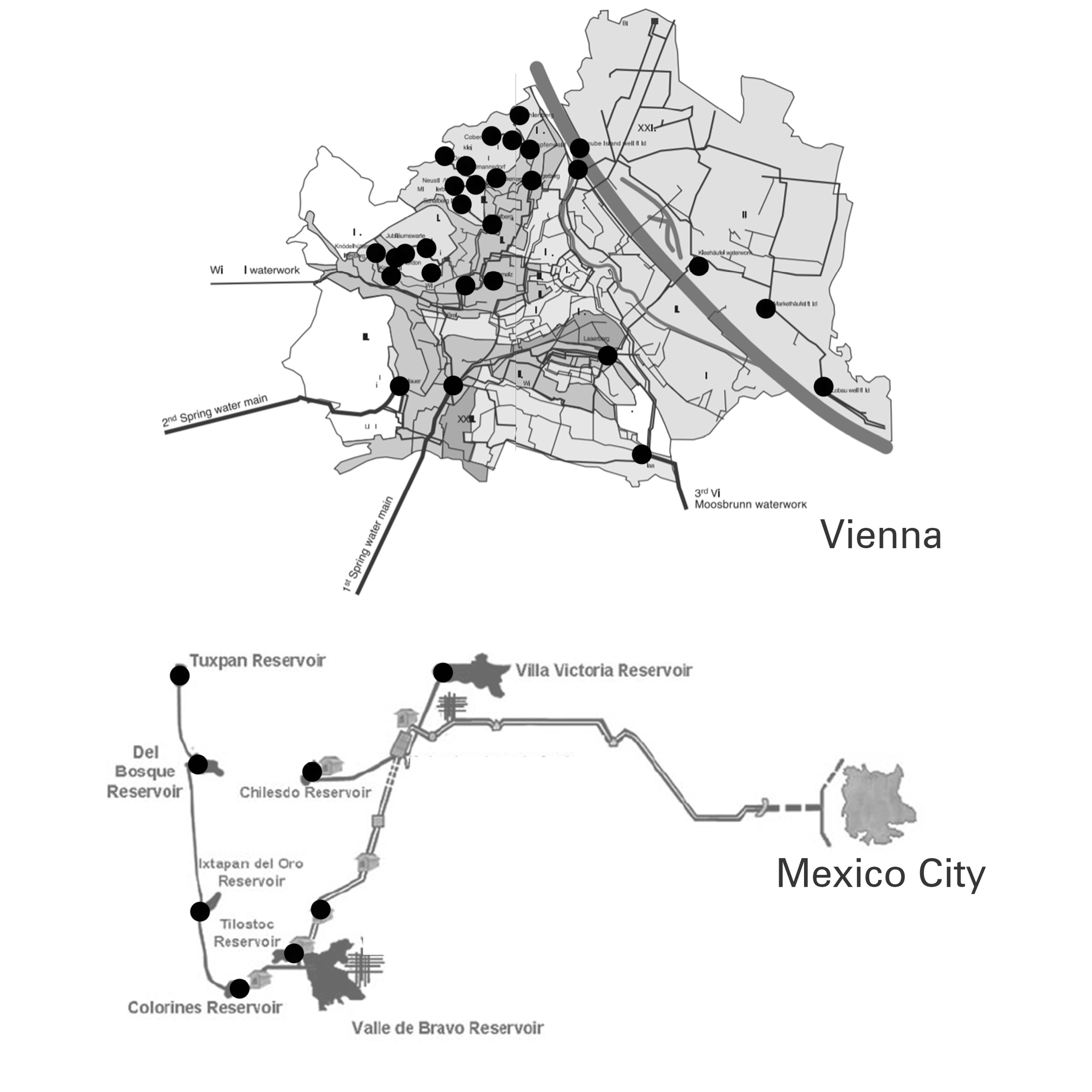
The first hour of rain in big cities is more polluting than fecal water.1 Rainfall drags contamination which ends up into sewers, rivers and seas. To prevent it, storm tanks not only remove polluted solids from the rainfall before it is redirected to the cycle, but they also absorb surplus water to avoid sewerage collapse, river overflow and city flooding. They function as a sewerage infrastructure consisting of a deposit dedicated to capture and retain the rainwater transported by collectors. They come into action when there is very intense rainfall and the drainage capacity of the water is lower than the volume of rain.
Madrid and Tokyo have the largest storm drainage systems in the world. Composed of a grid of oversized pillars cast from tons of reinforced concrete, these underground temples work as latent spaces waiting for the rain to come. While Tokyo’s storm tank is made up of a network of five silos connected by four miles of tunnels and Madrid’s tank is a large rectangular deposit hidden under a golf park, Mexico City has a different system. Contrary to the gigantic underground temples which function under a centralized management, rain water in Mexico City is managed by decentralized citizen initiatives such as “Isla Urbana”. They develop rainwater harvesting projects focused on the high areas to the South of Mexico City, where the largest number of homes don’t have connection to the drinking water.2
The dichotomies between superficial and underground, viewed and hidden, centralized and decentralized are blurred. Independently of their differences, these two systems respect the same cycle, being understood as actants3 with which the city negotiates its survival.
Christoffer-Rudquist. Japan’s Storm Tank
Sources: https://www.wired.com/2017/04/christoffer-rudquist-tokyo-drainage-system/
Sources: https://www.wired.com/2017/04/christoffer-rudquist-tokyo-drainage-system/
- The first hour of rain in big cities, https://www.lasexta.com
-
Isla Urbana, https://islaurbana.org/
-
Bruno Latour, Paris Ville Invisible, 1998

A reservoir is a natural or artificial water impoundment used to store water catering to varied functions like water supply, flood control, producing hydroelectricity, maintaining flow control, or for recreational purposes. Many reservoirs, such as the service reservoirs, provide raw water feed to a water treatment plant to provide drinking water. These service reservoirs are usually elevated and constructed as water towers in flat landscapes. At other times, they perform the function of cisterns by remaining underground in hilly or mountainous regions. These higher altitudes are vital in providing different pumping-pressures in varying zones. The typology of covered or underground reservoirs is functionally similar to the containers of water storage tanks. Such underground reservoirs perform a buffering function and act as an intermediary element between the water distribution system and the end consumer to satisfy residential, commercial, industrial and fire-fighting requirements.
Both Vienna and Mexico have a drinking-water supply system with twenty-eight reservoirs and seven reservoirs, respectively, at differing heights to ensure water supply in all parts of the city below through high-performance transport pipes. The Neusiedl am Steinfeld water reservoir in Vienna, and the water reservoirs of the Cutzamala System in Mexico, act as water storage tanks and, at times, as water treatment plants. Treatment procedures happen during its retention time and form an integral pause in the distributing system combined with various pipelines, aquifers, aqueducts, canals and pumping stations. The design of these reservoirs allows the particles and silts to settle out, in-turn purifying the water along with the presence of natural biological treatment using algae, bacteria and zooplankton. The Neusiedl am Steinfeld reservoir is the largest reservoir for Vienna's natural spring water supply, with four reservoir chambers 134.4 meters long and 120.4 meters wide, and with a filling height of ten meters. Two hundred and eighty-eight reinforced concrete columns support the ceiling of each container chamber. The Cutzamala system in ZMCM provides water from both the Cutzamala and the Lerma-Balsas river systems, where the network of seven reservoirs supply the water from a height of 1,300 meters. The water in these reservoirs is constantly monitored by control centres enabling the water distribution system to run at optimum efficiency.
← Back to Lexicon
Both Vienna and Mexico have a drinking-water supply system with twenty-eight reservoirs and seven reservoirs, respectively, at differing heights to ensure water supply in all parts of the city below through high-performance transport pipes. The Neusiedl am Steinfeld water reservoir in Vienna, and the water reservoirs of the Cutzamala System in Mexico, act as water storage tanks and, at times, as water treatment plants. Treatment procedures happen during its retention time and form an integral pause in the distributing system combined with various pipelines, aquifers, aqueducts, canals and pumping stations. The design of these reservoirs allows the particles and silts to settle out, in-turn purifying the water along with the presence of natural biological treatment using algae, bacteria and zooplankton. The Neusiedl am Steinfeld reservoir is the largest reservoir for Vienna's natural spring water supply, with four reservoir chambers 134.4 meters long and 120.4 meters wide, and with a filling height of ten meters. Two hundred and eighty-eight reinforced concrete columns support the ceiling of each container chamber. The Cutzamala system in ZMCM provides water from both the Cutzamala and the Lerma-Balsas river systems, where the network of seven reservoirs supply the water from a height of 1,300 meters. The water in these reservoirs is constantly monitored by control centres enabling the water distribution system to run at optimum efficiency.
← Back to Lexicon
Maps of the locations of reservoirs in Neusiedl am Steinfeld water system in Vienna and the Cutzamala water system in Mexico City.
Sources:
Sources:
- “Wasserbehälter Neusiedl am Steinfeld”, Wikipedia, accessed May 03, 2021, https://de.wikipedia.org/wiki/Wasserbeh% C3%A4lter_Neusiedl_am_Steinfeld
-
“Reservoir”, Wikipedia, accessed May 03, 2021, https://en.wikipedia.org/wiki/Reservoir#Controlling_watersources
- “Water for Urban Areas”, UNU, 2000, 243 p., http://www.nzdl.org/cgi-bin/library?e=d-00000-00---off-0fnl2.2--00-0----0-10-0---0---0direct-10---4-------0-1l--11-en-50---20-about---00-0-1-00-0--4----0-0-11-10-0utfZz-8-00&cl=CL1.5&d=HASH7ecfef951c65b8a6f0da56.8.5.2>=1